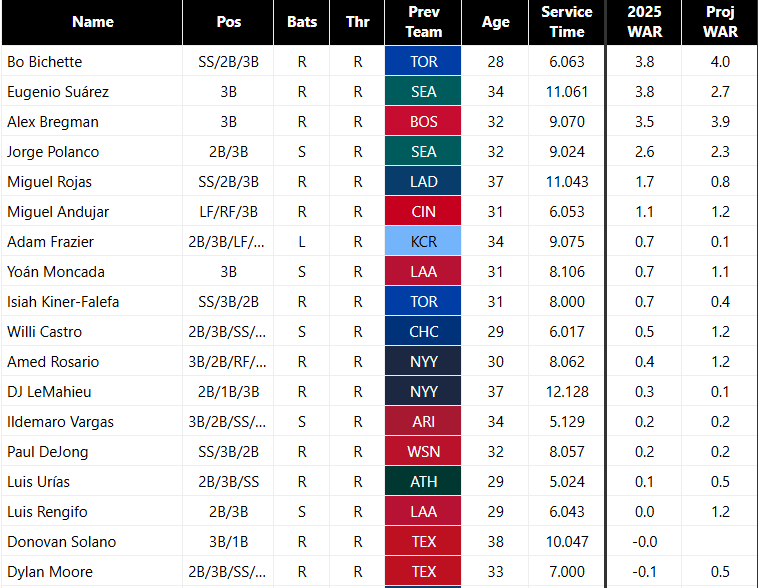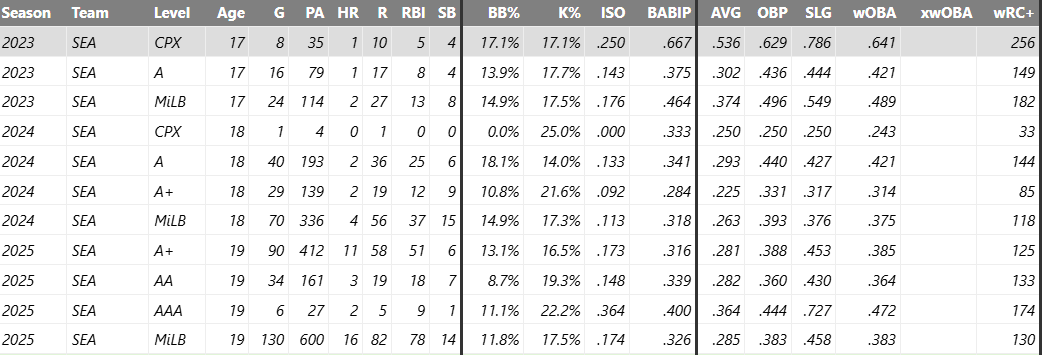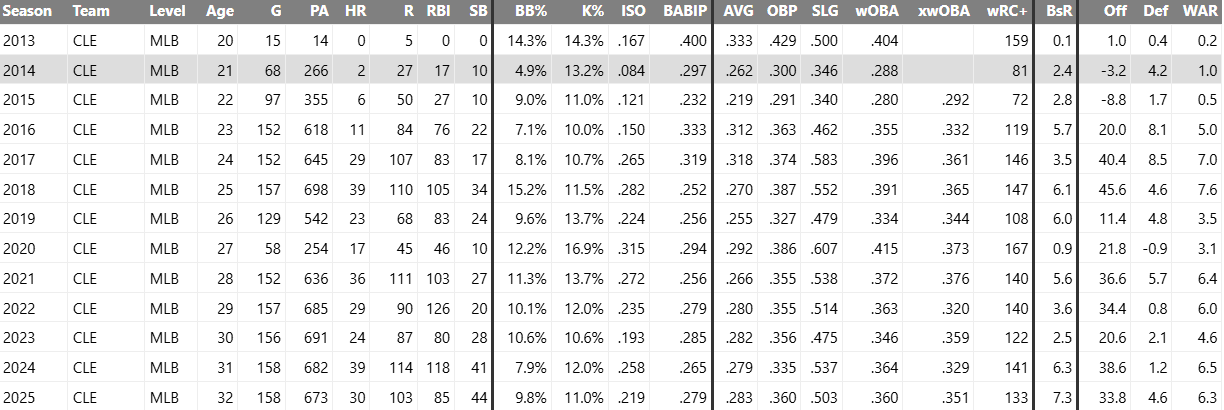Josh Naylor is back. What should the Mariners do next?
With Josh Naylor signed to a five year, $92.5-million contract, the Mariners have filled their first base hole for the foreseeable future and brought back one of their three major hitters entering free agency this offseason. His return provides much more clarity on what remains to be done and how much money the team has left to do it. Jerry Dipoto indicated in a postseason interview that the amount they finished with in 2025 (roughly $165 million) would serve as the baseline for their 2026 payroll. Most estimates prior to the Naylor signing projected the Mariners at about $132 million committed for 2026 after arbitration. That leaves around $15 million available if ownership does not increase the payroll beyond last year’s finishing point.
There is heavy speculation that second base or relief pitching is next on the Mariners’ list of needs, and that conclusion is understandable. But to really answer the question, we must first look at third base.
The Eugenio Suarez Question
You love Geno, I love Geno, everyone loves Geno. He is one of the most likable players in baseball, a beloved teammate, and a genuinely positive clubhouse presence. His on-field production has also been strong for most of his career. He has averaged 32 home runs per season, played reliable defense, and shown remarkable durability. Since 2016, excluding the shortened 2020 season, he has never started fewer than 143 games. He seemed to find his offensive rhythm again this past year, tying his career high in home runs (49) for the first time since his age-27 season in 2019. Now 33 years old and coming off an excellent offensive season, Suarez would be a great one-year addition to help push Seattle over the top.
However, several factors make a reunion unlikely. His defense took a step back, and although his arm remains elite, his range and first-step quickness have declined. His offensive production was still reliant on his home run total, which meant taking big swings and pulling the ball in the air. This approach produced a 29.8 percent strikeout rate, which was not offset by his relatively low 7 percent walk rate. He benefited from some home run luck and struggled to get the ball over the fence in Seattle, resulting in many warning track outs. He also had a poor second half and went ice cold during most of the playoffs. These signs point toward a player in decline, and one who may no longer have the consistent power to overcome the marine layer at T-Mobile Park.
Eugenio Suarez’s Fangraphs page
Additionally, Suarez is entering free agency following a 125 wRC+, 3.8 fWAR season at a time when the free agent third base market is thin. This gives him a realistic chance at securing a multi-year deal with a strong annual salary. The Mariners, already tight on payroll space after the Naylor signing, would be unlikely to meet that price unless he accepted a one-year contract under $10 million or ownership agreed to increase spending.
Given all of this, Suarez’s return appears improbable. That leaves the question of what alternatives exist.
Free Agent Options
“Third Base” Free Agents 2025-2026. Most of these guys don’t even play third.
The free agent market at third base is extremely weak. Bichette has never played third base, so the only clear star is Alex Bregman, who is coming off yet another strong season. He is 31 years old, has been remarkably consistent throughout his ten-year career, and has never posted a wRC+ below 114. He is coming off a 3.5 fWAR season in which he hit .273/.360/.462 with an .821 OPS and struck out at only a 14.1% rate. His defense at third is solid and he would unquestionably be an excellent addition from a talent standpoint.
However, Bregman comes with baggage from the Astros cheating scandal, and signing a player like that would understandably make fans and potentially even teammates upset. More importantly, he opted out of a contract with the Red Sox that would have paid him 80 million dollars over two seasons. That signals he expects a much larger payday this winter. Given Seattle’s payroll habits, it is almost impossible to imagine him fitting into their budget. The Mariners have not ranked inside MLB’s top 10 in payroll since 2018, and ownership has shown no inclination to push them there.
The rest of the free agent class is deeply unappealing. Most available third basemen either provide negative offensive value or fall into the category of mediocre depth pieces. None stand out as big enough upgrades over internal options to be worth spending money on. That leads to the next logical area of exploration: the in-house candidates.
Internal Options
There are many speculative possibilities, including players like Miles Mastrobuoni or Harry Ford being moved to third base, but these are unlikely. The two realistic candidates for 2026 are Ben Williamson and Colt Emerson.
Ben Williamson
Ben Williamson’s Fangraphs page
Williamson is the most MLB-ready option today. He played 703 innings at third base for Seattle last season. His defense was inconsistent, but at his best he made extremely difficult plays look routine. He spent much of his college and minor league career being moved around the field, including time in the outfield during summer leagues. Constant positional movement makes it harder to master a single spot, so it is reasonable to expect improvement if the Mariners commit to him full time at third.
His offense, however, is why Seattle traded for Suarez at the deadline and sent Williamson back to Tacoma. He struggled to make adjustments during his rookie season and posted very little power, slugging only .310. His walk rate dropped, which made his lack of power even more costly.
There were encouraging signs, though. His strikeout rate did not increase when moving from the minors to the majors, which suggests his bat-to-ball skills are legitimate. And in his 52 games at AAA to close the season, he put up the best strikeout-to-walk ratio of his career, reached base at nearly a .400 clip, and slugged .462. These numbers suggest he may still develop into an average or slightly above-average MLB hitter.
Colt Emerson
Colt Emerson’s Fangraphs page
Then there is Colt Emerson, who had such a strong season that he earned a call-up to AAA in September despite beginning the year in High-A Everett. Some believe he has a real chance to make the Opening Day roster in 2026. Others think he needs more time and may not be ready until late in the season or even 2027. The key point is that the Mariners appear willing to give him a legitimate opportunity similar to the one Julio Rodriguez received. If Emerson impresses in spring training, Seattle may not hesitate to promote him.
Emerson was outstanding at every level of the minors last season. He posted a 125 wRC+ in High-A, then improved to a 133 wRC+ in the more difficult offensive environment of AA Arkansas. In his brief six game stint in AAA Tacoma, he hit .364/.444/.727 with two doubles and two home runs. This is an extremely small sample size, but he showed no signs of being overwhelmed.
Shortstops often transition well to third base. Suarez himself began his career at shortstop, and Bobby Witt Jr. played more than 400 innings at third base during his first MLB season. Emerson could follow a similar path, playing third initially and eventually sliding over to shortstop when J. P. Crawford’s contract expires.
Trade Targets
The trade market offers several intriguing possibilities, although none are guaranteed to be available. Junior Caminero, Jose Ramirez, and Maikel Garcia stand out as the most compelling names. Even if they are long shots, the offseason always brings surprises. If conversations about Tarik Skubal are happening, then exploring these players is not unreasonable.
Junior Caminero
Junior Caminero’s Fangraphs page
Caminero is young, cheap, and already a star level player. The Rays are known for their willingness to trade anyone if the price is high enough and for seeking value before players reach arbitration. The Mariners have an excellent farm system and a strong trade history with Tampa Bay, which makes the idea plausible. Caminero would cost a massive haul, but he could stabilize third base in Seattle for many years.
Jose Ramirez
Jose Ramirez’s Fangraphs page
The Guardians were rumored to be open to trading Ramirez and Steven Kwan at the deadline, and their front office has a long track record of moving expensive players. Ramirez isn’t showing any signs of decline, but is 33 years old and is owed $69 million over the next three seasons, so they probably would have some incentive to get out of the rest of the contract. The complication is that Ramirez has a full no trade clause. Still, the Guardians decision to sell at the deadline despite having a playoff roster may influence him to waive his no-trade clause if it means joining a real contender who has proven they are willing to supplement a good roster at the deadline like the Mariners.
Maikel Garcia
Maikel Garcia’s Fangraphs page
Garcia is less established but highly intriguing. He broke out in 2026 and produced a 5.6 fWAR season after previously being an unremarkable player. His improvements appear sustainable and he offers great defensive versatility. He is now entering arbitration, and although the Royals have been gradually increasing payroll, they still operate within tight limits. With several players in line to get big pay bumps in arbitration, many Royals fans fear they may be forced to move someone. Kris Bubic is the most obvious choice, as he is close to free agency, but Garcia would bring back a stronger return than Bubic and is projected to receive a larger arbitration salary. This creates a realistic path for a trade.
Final Recommendation
With all that said, I think the best option for the Mariners is to try and re-sign Geno to a reasonable one-year contract, and try to acquire a utility guy who can play third base to provide some insurance if that doesn’t work out. They are really stuck between a rock and a hard place between third and second base because there aren’t many good options at either one, but the in-house options at third aren’t as promising as those at second base. That means third base should be first on the list in terms of priority, because it has the fewest good candidates to fill the position. However, Ben Williamson and Colt Emerson do offer legitimate upside at minimal cost, and Emerson in particular could become a foundational player if he is ready sooner than expected. So in the event that those attempts fail, they could let one of their young guys play and not feel too bad about it.
Realistically, the Mariners aren’t going to be able to fill every hole with a proven performer, and if you read my last article about the bullpen, you know that I believe relief pitching is a high priority this offseason. So their priority list should look more like a 1A, 1B, and 1C when it comes to third, second/DH, and relief pitcher. The front office should be pursuing options at all those positions simultaneously, with a willingness to let any of those chips fall first. The last thing you want to do is to focus too much on third base while all the good options for your other holes get gobbled up and you are left empty-handed.
-Isaac Harai








